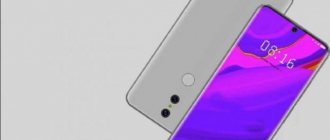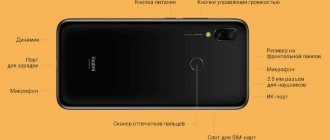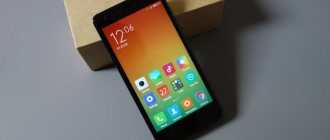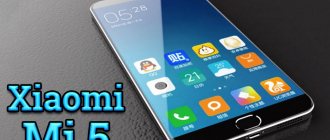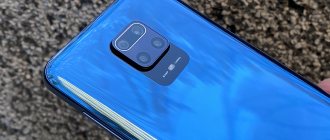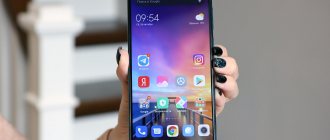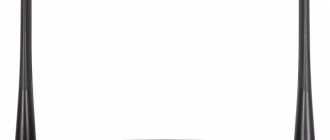Phone specifications
| Platform | Model: Qualcomm Snapdragon 625 Number of cores: 8 Clock frequency: 2000 MHz Video chip: Adreno 506 |
| Memory (GB) | Operational: 3 Built-in: 32 microSD support: up to 256 |
| Screen | Type: IPS Size: 5″ Resolution: 1920×1080, 441 PPI Number of colors: 16 million |
| Camera | Rear: 13 MP, F/2.2 Front: 5 MP Flash: LED |
| Battery | Capacity: 4100 mAh Fast charging support: no |
| Communications and wireless interfaces | Number of SIM cards: 2 Type: Nano-SIM, Micro-SIM LTE support: yes Interfaces: Wi-Fi 802.11n, Bluetooth 4.1, IRDA, USB Navigation: GPS IR port: yes NFC: no |
| Other characteristics | Operating system: Android 6.0 MIUI 8 Case material: metal, plastic Color options: grey, gold, silver Ports: micro USB, 3.5 mm audio jack, SIM card slot and microSD Dimensions: 69.6×141.3×8.9 mm Weight: 156 g |
Appearance and Design
The back surface of Redmi 4 Pro is made of aluminum with plastic strips under which the antennas are hidden. There are 3 colors of the smartphone: gray with a black front, silver with white and completely gold. On the back side in the middle there is a camera, flash, fingerprint scanner and Mi manufacturer badge. On the front there is a 5″ display, and below it are touch control keys. Also standard on the front is a front-facing camera, an earpiece and a notification light.
On the right side there is a power button and volume rocker. On the left is a tray for SIM cards or microSD. On the top of the phone there is a 3.5 audio jack and an IR port. Below are external speakers and a microUSB port.
Screen characteristics and interface
The phone has a 5-inch Full HD IPS matrix with a high resolution of 1920×1080 and a high pixel value of 441 PPI. The image on the screen looks bright: rich colors, wide viewing angles. Even in the open sun, the owner will be able to see the text or picture. The display is protected by durable glass. The user can change the color temperature of the screen in the phone settings.
Xiaomi redmi 4 pro screen.
The interface is convenient and simple. A beginner can easily understand all the tabs and icons. You can change the appearance of your desktop and icons in Settings or via Google Play.
Equipment
Xiaomi is trying to make packaging for its smartphone in the best traditions of Apple - minimalistic design, complete predominance of white color, the presence of only basic information and a great emphasis on the brand logo. When I see the emblem of a bitten apple on any piece of equipment, at that very second I understand which company the product is from. Also with the branded “Mi”. The box really intrigued me when I saw it for the first time. And, by the way, this was my first experience using devices from this brand. I immediately realized that this device would definitely not disappoint me. Contents of delivery:
- charger without adapter for Russian sockets (5V / 2A)
- Micro USB cable
- a lot of documentation in Chinese
- clip
Unfortunately, the Xiaomi Redmi 4 Prime does not come with any headset or case. The company willingly sells completely inexpensive headphones of acceptable quality, but separately, because this allows you to reduce the cost of the standard delivery package as much as possible. Recently, only the Neffos C5 Max has a headset included.
Sound Features and Communications
The external speakers in the phone are of average quality - the sound from them is neither bad nor good. This sound is enough for watching videos and for ringtones. Listening to music through external speakers is not the best solution. The sound from the earpiece is good, loud and balanced.
Redmi 4 Pro supports Dual SIM system. But you won’t be able to insert two SIM cards and a memory card into the hybrid slot at the same time. The smartphone operates in LTE frequencies, so users can enjoy fast mobile Internet.
Xiaomi Redmi 4 Pro (Prime) - The best Redmi ever?
How difficult it is sometimes to remain impartial. No matter how much you try to objectively evaluate mobile devices, some little thing still outweighs it, again and again persuading you to buy already proven solutions. So we ourselves don’t notice how, among all the variety of brands, we have developed favorites. And it doesn’t matter what nuances became the harbinger of a whole galaxy of purchased gadgets: the goodies of the system, the materials of the case, the presence of a slot for a second SIM card - do we remember?! The main thing is that now we have a manufacturer that we can rely on if anything happens. The funny thing is that we don’t like everything about our favorite either. Even within our favorite brand, we highlight the most successful or, conversely, failed models.
And for me, Xiaomi has become such a proven company, or more precisely, its Redmi sub-line, which this year has already reached the 8th generation. Of course, I didn’t own even a quarter of the gadgets they labeled, but from time to time I watched new products. It's no secret that the standout feature of this now independent brand was the devices called Note. But I was often seduced by younger smartphones, they’re just Redmi. They may be technically cropped, but they are compact, cute and comfortable. And if we forget for a moment about the models of the current year that ruined this golden rule, then I will never forget my first Redmi 3S, which is natural, and the most technically advanced compact - Redmi 4 Pro.
It’s no joke, very soon, on November 4, the device celebrates its third anniversary from the date of its announcement, and even though in my family it works a little less, about two and a half years - a more than respectable period. This is an excellent reason to remember it, exchange a few glances with contemporaries and once again make sure that in many, if not all, Redmi 4 Pro is still very good!
Assembly anywhere!
If we take the current plastic-colored madness out of our heads, the Redmi smartphones have hitherto tried to look respectable, where the key word is “tried.” Even the presence of aluminum in the body did not prevent them from being pressed, from bending during active use, and from plastic inserts from playing percussion in an orchestra. But the hero of my memories distinguished himself in this field.
Borrowing the appearance from its older brother, Redmi Note 4, the one for the Chinese market, this tough guy did everything in the best possible way. An amazing all-aluminum body that covers all the sides and gradually flows into the glass on the face - this is a real example of solidity! But it would be absolutely gorgeous if not for one plastic insert. No, not at the bottom on the back, where an almost premium separator was found, but at the top. This is a trick for better signal reception - according to the official version, or so that we do not delude ourselves - among the common people. But even his presence did not prevent the device from remaining absolutely silent. The fact that the plug remained on the back and did not flow onto the top and side edges also helped to avoid crunching - this is the case. And two - it was placed not at the bottom, where we most often squeeze the phone in everyday life, but at the top, where our hands reach less often.
The rest of the appearance of the smartphone is terribly typical. Below is the old charging port, framed by a plastic insulator - another mention of the fact that they were not greedy on materials. There are also amazing symmetrically arranged screws and slots. One is a microphone, the other is a speaker, everything is classic. The device is not without an infrared port, an additional microphone and a headphone jack - all on top. And the buttons with a combined tray are spaced along the side edges.
The reinforced concrete design could not but affect the fatness of the animal. Its thickness is close to 9 millimeters, but due to the slightly beveled sides it lies comfortably in the hand. Although the slipperiness is moderate, there is no reliable grip to speak of. In general, the device was and is an outlet for lovers of impressive and weighty forms, because with the same batteries, this sturdy device outweighs its comrades - Redmi 3S and . But, I repeat once again, this advantage is absolutely justified.
Reissue at the request of workers
If the back of former Xiaomi smartphones varied at the very least, the front panel was cloned countless times. The only difference was that in laptops the buttons were visible and the backlight flickered from underneath them, while in simple models the keys were drawn. And, despite the Prime (Pro) prefix, my copy is not yet equipped with a laptop.
Although this did not stop him from getting involved in a mind-blowing story. Initially, the gadget was released in three colors familiar to the 16th year. Buyers of the white and golden variations were immediately puzzled by the fact that with a colored front panel, the screen was framed by hefty black stripes, of a decent height at the top and bottom and from edge to edge on the sides. Similar sketches have already been observed among LeEco devices. Le 2, for example, was one. But from Xiaomi such a careless act, at first glance, was met with hostility. Naturally, many decided that they did not want to see it, and chose the black and gray color option, where the hefty stripes were invisible. Sellers on AliExpress realized this trick and greedily increased the price tag for the dark version. The difference in color schemes has previously been the hallmark of the site, but this time it reached more than three thousand rubles.
Several months of such disgrace have passed, and Xiaomi itself has come to its senses. It was decided to re-release the device with a white version of the front panel without this gaping blackness. Moreover, in both the silver and “gold” editions, the full face became exclusively white. And only after making sure that this was not a joke, but a truly unprecedented re-release of the device with external bug fixes, I finally waited for new variations to appear on sale and placed an order.
But, alas, it was not destined to see a full-scale launch of the sensational model around the world. Therefore, even the most persistent waiters had to be content with a re-flashed Chinese version of the smartphone, with the corresponding plug included.
By and large, even such a hit as Redmi 4 Pro, shining with my favorite multi-color event indicator, compact and all-metal, was not without its noticeable flaws. The Chinese version and black stripes are an excellent example of this. But these are not all the flaws of the contender for the best Redmi in history.
Clear but yellow
And again about the full face. Most of it is occupied by the screen, which, despite its generous clarity, with FHD resolution on a five-inch diagonal, turned out to be not at all so beautiful.
Having captured in my memory the day of the announcement of the sturdy one, I was about to suggest that the legendary Mi4 itself had descended to the budget segment. Finally, we've achieved breathtakingly smooth and natural images for such a modest final price, and maybe someone even admired the screen of their 4 Pro, but not me. In my copy, the white balance was too warm. And this despite the fact that neither now, nor even then, was I tempted by cool displays. Even my Redmi 3S was, although not as clear, much more natural in the image. And most importantly, the predecessor really was whiter. The “Four” has gone yellow, which cannot be corrected in the settings. There was no temperature adjustment slider here at all, and when I selected the word “cold” among the inscriptions, I saw nothing but a grayer and dirtier color.
The rest of the screen, of course, surprised me with its smooth picture and fine font rendering. But okay, the glass did not press through, the oleophobic coating almost did not come off, and during two and a half years of wearing it in various types of hand luggage, there were minimal scratches. Not a single one of them is deep. Only now I have glued protective glass onto the display, and only because branded accessories for older models become much cheaper over time. I paid a few pennies for a cool, absolutely transparent and even good gliding option from Cafele.
The reference minimum brightness for MiUI devices did not bypass this smartphone, and under the scorching rays of the summer sun the image remains readable. The main thing is not to forget to wipe the glass so that the prints do not glare.
Range for hits
All manufacturers infringe on their budget series, and this is a natural process. If you want good food at an inexpensive price, you have to curb your appetite somewhere. Xiaomi also adhered to a similar rule in most cases, but the firmware was an exception. The chipset, called Snapdragon 625, was still fresh and untested at the time of the hero’s release, but even then it was clear that this was a new milestone in energy efficiency. The Chinese engineers liked the result so much that, without further ado, they began to build almost their entire budget range based on this filling. Even such a seemingly specific product as Mi Max 2 received the 625th “dragon”. It also produced bestsellers: Redmi Note 4X, Mi A1, Redmi 5 Plus, and even Redmi 6 Pro, which became the hardware basis of the international Mi A2 Lite, inherited the chip from its 4th generation predecessor. And the more new products were released under the command of this monster, the calmer the owners of the “four” felt. If the hardware is still in use, it means it is relevant, and the manufacturer will not stop supporting the firmware overnight.
Weeks, months, years passed, and it became clear that the smartphone was even more ahead of its time. Take a look at today's Redmi 8; a fresh, but less fast chipset is working inside it. Look at the Redmi 7. Yes, the 632 is a little more agile than the Four, but support for 5 GHz Wi-Fi has been removed. My hero has two ranges in all its glory! Websites load quickly, videos load instantly. True, it takes some time to launch the same browser or video hosting, programs do not open right this second, but when a stable and fast signal is required, the device is beyond praise.
In terms of the speed and smoothness of the interface, the firmware is not far behind modern state employees, and does not even begin to stutter when the smartphone spits from a 32 GB memory crammed to the brim. The overcrowded Redmi 3S is incredibly slow today, but the 4 Pro is surprisingly fast. There is also not a lot of RAM - only three, and even less is available - a little over a gigabyte. Today, models with this variation are either completely cut out of decent models, or slightly less serious devices begin with them. And in 2016, the combination of numbers 3/32 was still distinguished by the word Prime.
In fact, the smartphone should have coped well with toys, for example, the eighth “Asphalt” was played and replayed on it and a bunch of simpler projects failed, but all for the time being. You know how it usually happens: you buy a smartphone with 32 GB, and at first it seems to be enough for both the programs you need and a couple of heavy toys. But over time, the necessary software grows, both quantitatively and in breadth. Two toys turn into one, which, if anything happens, is already waiting for its turn to be removed. Therefore, even if the “four” are gaming, they are somewhere in a vacuum, where the user does not use the software at all.
New shell, old android
Under the elegantly colored MiUI 10 interface, it’s difficult to guess which version of the robot our hero chose. Android is here, for a moment, already in its sixth revision, namely 6.0.1. How is life with this in 2019?! Not bad, I would even say - unnoticed. Applications are updated, the interface does not slow down. Maybe this is the key to the smooth operation of Android: just don’t update the system itself, but only the add-on?!
The difference with modern versions of applications is literally in the details. I didn’t notice that “stories” were added to Google Photos for this smartphone, when other devices in my environment had them for a long time.
Of the larger ones, the “four” does not have face unlocking, but in general it is not needed. Why, when the scanner works quickly?! Yes, not at supersonic speed, but much faster than on the Samsung Galaxy M20, for example. It is possible to relatively fine-tune the LED indicator, but there is no gesture control for you. Which is logical. Why, when there are sub-screen keys, on each of which you can assign an additional action by long pressing.
Three gigabytes today, of course, are not enough to keep even a couple of applications minimized at the same time. This is if it is voluntary. And forcibly, MiUI allows you to fix the program in the background by putting a lock on it.
And if you don’t delve into the details, then in front of me is the same interface, hated by some, revered by others, and you can either tolerate it or ardently adore it. MiUI no longer evokes emotions in me. I value many functions, for example, creating a clone of absolutely any software, but many are not in demand for me. It still seems to me that the shell lacks an extreme energy saving mode and a simplified interface that turns this sophisticated communicator into a smart grandmother's phone.
Unfortunately, bugs, crashes and reboots have happened to the phone over all these two and a half years, not without it. But it was especially difficult in the first winter, when the smartphone simply turned off from time to time. At first I thought that this animal was simply not adapted to the cold. This has already happened with my old all-metal phones, but the situation was repeated at home. However, a miraculous update corrected this jamb, which, as it turned out, was far from isolated. And periodic crashes and freezes are still observed. Not often, once every few months, the phone freezes and reboots, sometimes on its own, sometimes forcibly. And some applications crash more often.
Call, don't get through
Often, on devices intended for China, there is a certain shortage of frequencies on average around the world. B20 is absent in almost 100% of cases, often B7 is in flight, but how this is felt in daily use in the Russian outback is almost never specified. I didn’t find out exactly which bands are not in the firmware, and especially what frequencies the operators use in the Urals. It's for the better. The less you worry, the more you cling to the network. In my case, with Beeline and MTS in the Chelyabinsk region, everything is tenacious in terms of 4G.
The voice quality is also good. There are no telephone features in the smartphone. Both external and vocal speakers don’t set records for volume, but they cope with their task; I don’t want to add more power. The microphone is also decent. Only when I get a call from this “four” on the speakerphone, I notice that the device swallows some of the sounds, and you have to stay as close to the microphone as possible. It is not very sensitive for speaking loudly.
But this dialer also had its dark times. More than a year has passed since the phone sent its owner outside the network access area. Although I didn’t forget to go online. And what’s more, the owner himself calmly sent SMS and made voice calls, not noticing that for others he was an “out-of-range subscriber.” Yes Yes exactly. I call, others call, and the owner of the smartphone seems to be in a bunker, but at the same time the Internet works and you can message him via messenger and inform him about it. The owner reboots and gets in touch with his loved ones as if nothing had happened. This situation was repeated about 3-5 times, I don’t remember exactly how many times, but more than once for sure. And somehow it resolved itself with the next update. The settings were not reset, the SIM cards were not changed.
Sound like sound
Traditionally, Xiaomi does not pay due attention to the hardware sound of smartphones, relying entirely on the capabilities of the chipset and not installing amplifiers, DACs and other gadgets.
But there are more than enough software marketing tricks. According to the laws of the genre, the sound effects settings contain many presets for various models of brand accessories. Call it advertising, or call it caring for customers. And so and so, the influence of these profiles on the sound is felt in any “ears”. Most of them, of course, are useless, but you can find three normal ones.
A smartphone convenient as a player is fully enough for 16-ohm earphones, both in terms of volume reserve and frequency coverage, as far as I can hear. But for something more serious, I’m afraid, the “proshka” is not suitable. In the Sennheiser HD 449 with an impedance of 32 ohms, the sound is not so rich, and the volume is barely enough. In principle, nothing surprising. Redmi 4 Pro is an excellent travel and, importantly, compact player for the undemanding listener.
The external speaker does not pretend to be a multimedia speaker at all. He is not quiet, although he does not drown out with his intense scream. I am glad that at maximum volume levels the sound does not become a mess and does not turn into a squeak.
Fewer cameras are better
Looking back at the current day, the Redmi 4 Pro's camera design is indecently simple. No second modules at the back, no background blur effect in portraits and other photographs. Not a single update, of which there were insanely many, endowed the 13-megapixel peephole with artificial intelligence and other hotly sought-after options. But does all this make this camera bad?!
I would even say the opposite. A primitive interface, a minimum of modes, such as HDR, panorama and truncated manual settings without focusing and shutter speed - everything only enhances this elemental camera to the point of genius. Turned it on, took a picture, and moved on. And the result is more than good.
In sunny weather, and generally outdoors with sufficient lighting, the pictures are amazing. I like them without reservation, I want to keep them in my family digital album. But at home everything is much worse. But again, the street light filling the room sometimes works wonders here too; taking good pictures indoors under ideal weather conditions is not a problem for the camera. But the closer to evening, the more difficult it becomes for the soapbox. It is still possible to get a decent shot within four walls under artificial lighting, although you will have to not move either the subject or yourself, which in itself is quite difficult. I'm glad that moderate amounts of noise fill the frame and don't destroy the results of your efforts.
Examples of photos:
A few more examples
Nature in cloudy weather:
HDR did a good job when the photo was taken against the sun. At the same time, practically nothing was visible on the screen:
Indoors under artificial light:
Indoors with natural light from a window:
An album with these and other shots is here.
In a word, the quality and convenience of shooting is exactly what you expect. In many cases better than on Redmi 3S. In addition to the front camera. The front module almost completely copies the result of my previous budget employee, which means it does not represent anything good for a self-portrait artist and does not deserve attention. And even the more modern budget phone, Asus Max Pro M1, is often not so good during the day. And in terms of the speed of creating a snapshot and launching an application, both Xiaomi and Asus are approximately equal, sometimes even with a slight advantage of the “four”.
Two days? Yes Easy!
I was familiar with the serious autonomy of Chinese state employees first-hand, but this hero surpassed everything I had before. It would seem that the increased screen resolution and the new, untested, and faster processor should have barely maintained the success of my previous Redmi 3S, but the firmware suddenly surpassed it.
In the first months, the smartphone lasted three long days without recharging, bringing back the Nokia 5230 to the glory days, which lasted exactly the same amount of time, but not in such a burning mode. The “four” held on, despite three hours of screen time a day, and sometimes a little more, remained connected both via Wi-Fi and via 4G, and asked for recharging only at the end of the third day. I didn’t even have words, I didn’t understand: how?! But, apparently, energy-efficient hardware, complete with a huge battery and fairly quiet use, without heavy games, determined the fate of the tough guy. It was then that it began to seem to me that now all phones would last the same amount of time.
But this, of course, did not happen. The long battery life prompted owners to use their devices even more harshly. In addition, screens grew, it became possible to run two simultaneously running applications on the screen, and further efforts by manufacturers to expand the vitality of devices did not bring the desired result.
In theory, this smartphone did not need the dialer mode, which I had been dreaming about in MiUI for so long. It held up well enough both when in use and when idle.
And the funny thing is that my Redmi Note 4X on the same hardware, with the exact same battery, for some reason lived noticeably less. Which once again confirms the conveyor component of all “redmics” without exception. Where the firmware was curbed and where it was not, you won’t guess until you experience it yourself.
I don’t remember whether the ability to charge a smartphone quickly was discussed during the announcement, but this bastard can do that too. The Quick Charge icon in the status bar lights up, and the device itself writes that it is “fast charging” for just under two hours. I don’t know which generation the firmware understands; the chipset is stated to be the third. I have a left adapter, I bought it in the Rock store on AliExpress, and Noname came with 18 W ambitions. From a complete Chinese unit, the “four” is replenished in at least two and a half hours, which does not make Quick Charge technology much advantageous for this model, but the very fact of support speaks volumes. The device was almost not cut down, and that’s great.
Today and yesterday
If we put aside the nostalgic appearance and look at the hero as a rival to modern state employees, then it suddenly turns out that there is almost nothing to change the “four”, but is there a reason? Yes, there is, there is one fly in the ointment, but! Judge for yourself, the screen is not the coolest in terms of color reproduction, but at the same time, it is amazingly clear. The assembly is amazing: so far nothing has crunched or become loose. Android is a bit old, but the shell is still being updated - that’s also not a reason. The camera is simple, without “width” and “bokeh”, but why is all this? Among state employees there are so few devices that have one normal module, and not a bunch of stupid ones. This sawn-off shotgun shoots like some double-barreled shotguns have never dreamed of. Lives for a long time, even Wi-Fi at 5 GHz on site is a fairy tale, not a smartphone. Is it not because of the lack of USB Type-C that we should change it? There is no NFC, but that's not a problem.
But the Achilles heel of this solution lies in the RAM/ROM doublet. There are no games in the smartphone, there is a memory card for photos and videos, the entire internal storage is used only for basic programs, and for them it is not enough. The system constantly complains about its overcrowding. In general, in the current realities, 64 GB of ROM is needed like air and not only for toys, but even for simple everyday life.
And the most interesting thing is that skipping several generations and taking something modern from the Redmi line will no longer work. And all because the latest “firmware” was marked with the number 6 and in hardware only repeated the “four”. There will be no increase, as you can see. Redmi 7 is a little faster, but without dual-band Wi-Fi and an FHD screen, it’s not at all a candidate for purchase. The G8 has completely weakened, and in terms of chipset agility it even loses to the hero. These facts, on the one hand, make my copy a pearl, noticeably ahead of everything that was produced under the simply Redmi brand, but on the other hand, it even makes me feel somehow sad. It feels like Xiaomi is simply marking time, and people continue to buy their devices out of inertia.
In order to find a fair replacement for the gadget with an increase in all indicators, perhaps, except for autonomy, you will have to upgrade the class. Redmi Note 7 would have been ideal, but the package with this smartphone did not reach me, forever stuck in the status “awaiting shipment from Switzerland.” While the thriller on the return of funds lasted, the sweet couple of Note 8/8 Pro gained momentum. If the younger one is quite strong, but still overrated, the budget phone, then the second one is opposed by another Xiaomi smartphone - Mi 9 Lite. In all respects, this is an excellent replacement for today’s hero, except for its size and cost. The Mi A3 is a little less slick, the screen of which everyone criticizes, but I saw it - it’s not at all as bad as it’s painted out to be. So if you don’t need MiUI and NFC, then you can consider it.
Meizu looks much more interesting today. They are getting cheaper. There is Meizu Note 8, which I praised, although it is not such a noticeable upgrade of the firmware, but it is very reasonable. But I don't want to take it a second time. And not because he changed his mind. No, my brother is still happy with the purchase, as am I, only now in the role of an outside observer. I still want something new, something to learn. Meizu X8 is strong, but not so long-lasting, and Note 9, still from the same notorious company, is very entertaining today. But! We see with what frantic force the Note 8, , and 15 Lite fell in price, as if the autumn leaves had spread to online commerce. So there is every reason to assume that Note 9 will mature after some time and will be even more attractive in price.
Among other brands, Huawei is as good as always, it’s a pity that the Mate 20 lite is almost out of sale, but the compact Honor 10 in some networks is approaching 15 thousand rubles and is also running out. Realme Q looks good from Chinese online sites. In addition, you can’t let go of the Galaxy A50, which very often appears on Tmall for 14,000 rubles.
You can aim upward indefinitely. Fact is fact, without going beyond 12 thousand rubles, it is almost impossible to choose something to replace Redmi 4 Pro. Which simultaneously elevates today’s hero above the heap of endless state employees, but also adds headaches when choosing! And it hits your pocket, not without it.
Conclusion
Even if today I have to get rid of all Xiaomi smartphones, even if I never want to hold or buy their devices again in my life, which is unlikely. Even with such a fantastic scenario, I will leave Redmi 4 Pro! I’ll leave it as the most memorable representative of the Redmi line at the moment. Even with all its shortcomings, which one way or another pass through all the company’s smartphones, I liked this model the most.
These might be big words, but the gadget was slightly ahead of its time. It seems to me that Xiaomi deliberately slowed down the development of its younger line, because they themselves seemed to be afraid of their brainchild. After all, if the followers of the firmware continued to develop hardware and software, and not grow diagonally, then they could soon overtake the Redmi Note series in popularity. And the manufacturer would hardly be able to increase the power of its public sector employee for a long time without serious financial consequences for itself. Therefore, the development of the line had to be restrained, and the successors to the hero Redmi 5 Plus and Redmi 6 Pro were transformed only externally, without undergoing changes in the chipset.
But the hero was loved not so much because he became a springboard for future bestsellers, which in fact is not so important to the owner. And the fact that the smartphone still hasn’t become loose, hasn’t become covered in a bunch of scuffs, hasn’t started working for three hours and turning off – that’s what’s really valuable. And even though its front panel is not so impressive, there is little memory, and the Android is noticeably older than all today's devices. A classic block made of reliable materials, pleasantly cooling and relaxing to the hand, cannot become obsolete.
Camera description
The 13 MP rear camera with f/2.2 aperture and autofocus takes fairly clear and colorful pictures outdoors in daylight. Photos are detailed and sharp. In artificial lighting conditions, the quality of images decreases, the photos turn out “noisy” and blurry. At dusk or simply in poor lighting, a dual LED flash will help. The 5 MP front camera takes average-quality photo portraits.
Camera Xiaomi redmi 4 pro.
The video is recorded in 1080p resolution, which is enough for an average video clip. There is no optical stabilization, so the image will shake.
⇡#Camera
The key difference between the Note 9 Pro and the Note 9S, along with NFC, is the improved camera. But it’s curious that there was almost no upgrade compared to the Note 8 Pro.
At the head of the table sits the 64-megapixel Samsung ISOCELL Bright GW1 sensor, which we also saw on realme XT, for example, and on the flagship vivo NEX 3. Built according to the already traditional Quad Bayer scheme (or TetraCell - a Samsung trademark) with four subpixels, combined under one filter, it offers shooting at a default resolution of 16 megapixels with the ability to upgrade to ultra-high resolution if necessary.
| On the left is a 16-megapixel photo, on the right is a photo with a resolution of 64 megapixels | ||
As we have written more than once or twice, this scheme gives an advantage when shooting at night or when using digital zoom, where the picture, taken using all subpixels, is then “compressed” to the desired format. Shooting at a resolution of 64 megapixels (48, 108, or whatever else is available in QuadBayer cameras) does not make much sense - with ideal lighting you can get increased detail, but I would not say that the improvement is radical and worth it. At night, the 64-megapixel mode is useless. It is also worth considering that the size of each frame with a resolution of 9248 × 6936 is on average from 14 to 31 MB (in the latter case, using HDR), that is, the memory will fill up very quickly.
| From left to right: shooting at wide angle, standard focal length and 2x zoom | ||||
The sensor is quite large (1/1.7″), which made it possible to keep the size of an individual pixel unchanged compared to 48-megapixel modules - 0.8 microns. The lens lacks optical stabilization, but has a fairly high aperture ratio - f/1.9. The main camera has a phase detection autofocus system. The camera app offers both 2x “hybrid” zoom and an extended viewing angle. For this, a wide-angle module with an 8-megapixel sensor is used (sensor size is 1/4″, individual pixel size is 1.12 microns) and an f/2.2 aperture lens that does not have autofocus. It makes sense to shoot at a wide angle only in good lighting - at dusk and especially at night, this camera fails. The zoom, despite its software status, works quite confidently, including in low light conditions - and what’s more, a special night mode is applicable to it.
| On the left are pictures in the default format, on the right are with night mode activated | ||
Xiaomi Redmi Note 9 Pro allows you to get a good picture at different focal lengths during the day, but at night its capabilities are limited. Night mode, which combines multiple shots taken at different exposures, helps a little, but due to the lack of an optical stabilizer, its capabilities are limited. In its class, Redmi Note 9 Pro retains its position, but will not reach new heights relative to what Redmi Note 8 Pro has already achieved.
The new module differs from the Redmi Note 8 Pro camera in only one way - an improved camera for macro photography. Instead of a two-megapixel camera without autofocus, there is a new one installed here, with a resolution of five megapixels and autofocus, but it has a less fast lens - f/2.4. The new product is perfect for super-close-up photos. The fourth camera is needed only for portrait mode - this is a depth sensor.
| On the left is a picture without AI, on the right is with AI | ||
Algori is familiar from last year’s models or Redmi Note 9S - they increase the saturation and brightness of the frame, but do it quite carefully. Xiaomi Mi 10 has stepped forward in this regard - and it is not clear whether this is a plus or a minus for it, where the AI can overdo it. In Redmi Note 9 Pro, the AI icon can be left untouched; the intervention of neural networks here is not so significant and is almost always appropriate.
The portrait mode blurs the background quite well and allows you to achieve good results when shooting half-length and full-length portraits. But it is no longer suitable for close-ups - there is only one focal length, zoom is not available here. Accordingly, geometric distortions of the face will be very noticeable in close-ups. In portrait mode, you can adjust the degree of blur, add beauty, various preset effects, and turn on “film mode,” which produces a narrowed image with black bars around the edges and a warmer tone.
| Xiaomi Redmi Note 9 Pro camera app interface | ||||
The camera application is standard for MIUI 10. There is a watermark enabled by default indicating the smartphone model you are taking pictures with. Don't forget to turn it off in a timely manner - although you can erase it later, in the gallery.
Gallery of pictures
View all images (13)
Video recording is available in 4K resolution at up to 30 frames per second or Full HD at up to 60 frames per second. Before shooting, you can select a viewing angle (extended, standard or 2x zoom), but you cannot switch between them during the process - only use digital zoom by cropping the image with loss in quality. There is also a slow motion mode with a frequency of up to 960 frames per second (resolution - 720p). The “video clip” mode allows you to adjust the shooting speed (albeit in a smaller range), add a kaleidoscope effect or beauty with some effects. Nothing that cannot be done during post-processing, but will help the blogger save time on this very post-processing.
The front camera is not bad, but strange. The resolution is normal - 16 megapixels, but the lens has a low aperture, f/2.5. In normal lighting, you can take excellent selfies, especially since software background blur and a standard beauty feature are available. But in low light, the picture will already be inferior to what you can get on the Note 8 Pro, for example.
Performance testing
The phone runs on an octa-core Qualcomm Snapdragon 625 processor and 3GB of RAM. The graphics are processed by the Adreno 506 chipset. These characteristics allow the smartphone to function correctly without freezing and work with several tabs at the same time. In the antutu test, the gadget scores an average score of about 90,000 points.
Qualcomm Snapdragon 625.
Comparison with other manufacturers
| Xiaomi Redmi 4 Pro | Meizu M3 Note | Huawei Honor 5x | |
| CPU | Qualcomm Snapdragon 625, 8 cores, 2 GHz | MediaTek Helio P10, 8 cores, 2 GHz | Qualcomm Snapdragon 616, 8 cores, 1.5 GHz |
| RAM (GB) | 3 | 3 | 2 |
| Screen | IPS, 5″, 1920x1080, 441 ppi | IPS, 5.5”, 1920x1080, 403 ppi | IPS, 5.5″, 1920×1080, 401 ppi |
| Camera | 13 MP, autofocus, dual flash | 13 MP, phase focus, dual flash | 13 MP, autofocus, dual LED flash |
| Battery | 4100 mAh, non-removable | 4100 mAh, non-removable | 3000 mAh, non-removable |
| Housing material | metal, plastic | metal, plastic | metal |
| Dimensions and weight | 141.3×69.6×8.9 mm 156 g | 75.5×153.6×8.2 mm 163 g | 76.3×151.3×8.2 mm 158 g |
Display
Xiaomi Redmi 4 Prime has an IPS LCD matrix from an unknown manufacturer. Looking at the average price, I think that Xiaomi was unlikely to be able to supply a screen from Sharp. However, the display does not cause any complaints. The only disappointment is that the protective glass is not Gorilla Glass. I think that the situation with UMi Plus E is repeated here, i.e. they install cheaper analogues to reduce the price as much as possible. Fortunately, no scratches appeared on the glass during testing.
The display does not fade into yellow tones, like the Lenovo Vibe X2 (pictured with the backlight of the under-screen buttons turned on). After comparing the matrices of the two devices, I came to the conclusion that the screen of the Redmi 4 Prime is very similar to the UMi Plus E, which I already mentioned. There is a slight problem with black color at extreme angles. It’s not that it fades too much and ceases to be black at all, but it gives off a gray tint (you can compare for yourself by looking at the upper left corner of the two displays).
- 5 inches
- resolution 1920 x 1080 pixels
- dot density 441 ppi
There is a little more saturation, which, in principle, can be written down as a positive quality (very noticeable if you compare the purple color), but the maximum brightness margin is less.
By the way, the oleophobic coating is excellent, fingers glide, while fingerprints and any traces are barely noticeable. And in general, it’s hard to imagine a smartphone without a film that repels fats from the touch screen. The 2.5D glass effect is present, but very weak. It fits the theme and adds some flair to this smartphone.
Customer Reviews
Vladimir, 30 years old, Smolensk: “Redmi 4 Pro is a good phone. The high-capacity battery and processor are the main advantages.”
Anastasia, 25 years old, Zhukovsky: “The best model is Redmi 4 Pro 32gb black. Corresponds to the price. The phone suits me."
Konstantin, 28 years old, Moscow: “I don’t regret the purchase, the smartphone is productive and easy to use.”
Dmitry, 35 years old, Saratov: “High-quality phone at an affordable price. The smartphone is 2020, but remains relevant.”
Ksenia, 26 years old, St. Petersburg: “I recommend it for purchase. Redmi 4 Pro is a decent device. The Antutu test shows 89670 points.”
Two days at full load? This is the norm!
The new budget phone has the same battery as the Redmi Note 4 - 4100 mAh. For the average modification of Redmi 4, this is simply a colossal figure. For the Prime modification, it doesn’t look so impressive - it’s still FullHD, a powerful processor. Although in general for a budget employee with a 5-inch screen this is a very serious bid for longevity.
But the processor has perfectly optimized power consumption. Therefore, Redmi 4 Prime easily outperforms not only its classmates in terms of autonomy, but also a lot of Chinese smartphones with a battery larger than 5,000 mAh.
Only the Oukitel K10000 with a 10,000 mAh battery can compete with it. This is what life-giving optimization does!
Without load, a smartphone can live for months, at maximum load - for a day or more. It can be discharged in less than 20 hours only in tests or 3D games with 4G enabled.
Of course, if you don’t turn off the screen at all, without a break, the operating time in heavy applications and 4G will be “only” 11 hours. Karl, 11 o'clock!
That's more than a working day if you don't look away from your smartphone at all! At the same time, watching streaming video over 4th generation networks eats up the battery in 15-16 hours.
